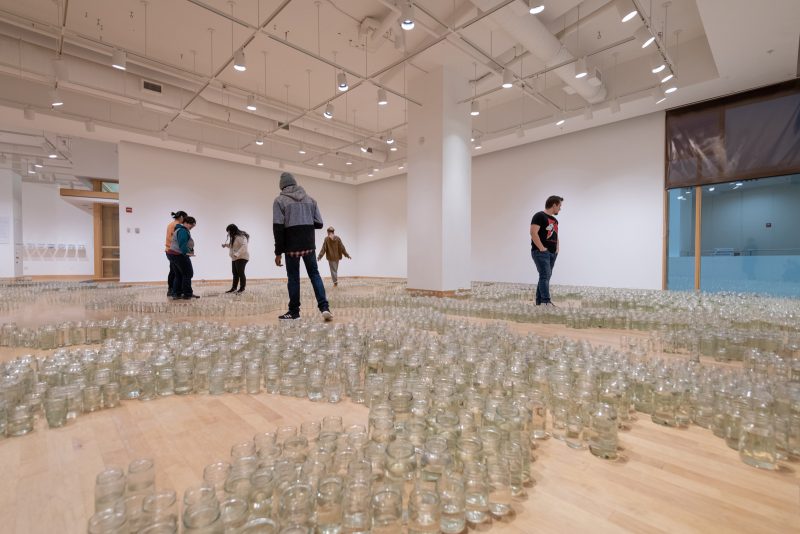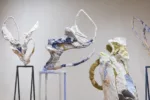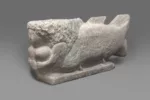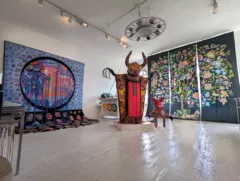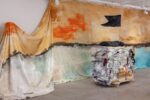[ED. Note: Due to COVID-19, Dr. Mona Hanna-Attisha’s in-person lecture is cancelled. Check out “What The Eyes Don’t See” here. This exhibition is also closed to the public. We encourage you to experience the exhibition virtually by visiting the embedded links.]
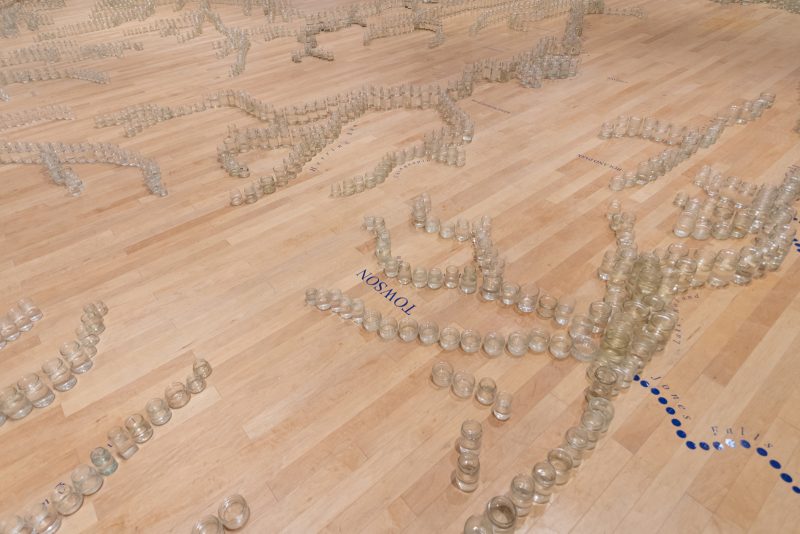
In a world of environmental crisis, Towson University addresses the issue of water quality this spring with a series of free events that are open to the public, including an exhibition by environmental artist Stacy Levy (full disclosure: I co-curated this exhibition along with Erin Lehman, Director of the Department of Art + Design Galleries). However, while planning the exhibition began the conversation, it gradually became only one element in a spring rich with programming, including an environmental conference to open April 16th with a keynote event: “A Conversation with Dr. Mona Hanna-Attisha,” a pediatrician, professor, and public health advocate and author of the book What the Eyes Don’t Seef, which tells the story of the Flint, Michigan water crisis. The New York Times named it as one of the 100 most notable books of 2018, and it was chosen as the Maryland One book of 2019.
Large universities, unlike museums, have access to and can take advantage of their own experts and departments, programs, and offices, resulting in rich interdisciplinary programming. In this instance, the College of Fine Arts and Communication (Departments of Music and Art + Design), the Jess & Mildred Fisher College of Science & Mathematics (Department of Biological Sciences), the Office of Sustainability, the Office of Civic Engagement & Social Responsibility, and Cook Library, collaborated to produce extensive programming around the issue of water. Scientists, curators, artists, musicians, librarians, and specialized program directors worked together to address the issue of water quality from their own perspectives.
Levy, who lives in rural Pennsylvania and who holds an MFA in sculpture from Tyler School of Art and Architecture, Temple University, and a BA in Sculpture with a Minor in Forestry from Yale University, is familiar with this kind of interdisciplinary approach as she often collaborates with scientists and landscape architects. She regularly creates works in the land and on the water to help mediate environmental problems. In 2018, she won the Henry Meigs Award for Environmental Leadership, and in 2019, the Penn Future Award for Women in Conservation. Readers can see a list of her commissions on her website, along with images of her many projects.
Levy writes: I am a sculptor with an urban forestry background whose interest in the natural world rests both in art and science. My art celebrates the often-unnoticed presence of the natural world in places we experience every day. I work with natural forces like wind, rain, erosion and climate change, plant growth, bird habitats and tides. I have explored the many aspects of urban waters, from the micro to the macro, and I have looked at water from many different angles: from puddles to watersheds.
“Watercourse” is a large, graceful installation that demonstrates the interconnectedness of local watersheds by mapping them in three-dimensions onto the nearly 2, 500 square foot floor of the Center for the Arts Gallery at Towson University. Students, faculty, and staff accompanied the artist for many days of water collection. In the end, we collected nearly 200 buckets of water from the various waterways in Baltimore County, and their contents filled close to 8,000 recycled jars that form the corresponding waterways of the map. It was a herculean effort.
Levy feels it is important that people know their streams, their names and locations, in order to protect them. Thus, the map includes identifying text in blue-colored Times Roman—employed in official maps of creeks, streams, rivers, bays and other waterways. Today, many waterways underlie roads and suburban developments, but in the past, they were the “roadways.” The title of her lecture for the opening of the exhibition was “Picturing Water: Art as A Verb.” A film collaboration between the artist and her videographer, Jonathan Bojan, about the project can be viewed here.
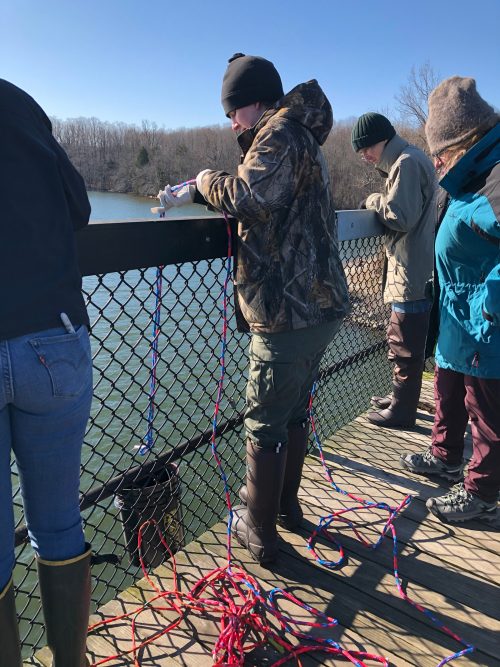
Maryland is rich in bodies of water. They are the result of a large glacier melt beginning about 10,000 years ago. The Chesapeake Bay was formed from the increased size of the Susquehanna River and the eventual mixing of salt and fresh water.* While this exhibition looks at Maryland waterways, Pennsylvania’s decisions on water pollution also affect the Chesapeake Bay. A recent report by the Chesapeake Bay Foundation concluded that Pennsylvania’s proposal to combat water pollution was not adequate, prompting Maryland Governor Larry Hogan to send a letter expressing his concern to Pennsylvania Governor Tom Wolf.**
Information about the “dissolved salts” content (conductivity) and acid-base quality (pH) of stream waters collected by biologist Susan Gresens of Towson University and her students are included in the watershed map installation, on display through an aesthetic visual representation designed by Levy of jars filled with varying amounts of marbles to represent salt content. Gresens explains that conductivity measurements are a useful representation of the total amount of “salts” dissolved in the water. These salts represent different compounds, some natural from local bedrock, others introduced by humans. In watersheds with winter snow and ice, road salt is the major contributor to conductivity.
While these salts keep road surfaces safe for drivers, conductivity is also a “fingerprint” of urban development; the more roads there are, the more driving there is, the more road salt is used. Levy explains that just as we cannot drink salty ocean water, microorganisms and other life forms, like fish and salamanders, cannot tolerate an overly salty environment.
The artist’s map design also demonstrates her fascination with dendritic patterns (branch-like structures) found not only in waterways, but also throughout all life forms, including the human vascular system. Levy comments that “This complex of streams and rivers create capillaries of life-giving fluid.” To allow for more viewer space, vinyl dots mark some waterways in the installation, generally forming the tail end of a curving river or creek, completing a dendritic pattern. This exhibition is an excellent representation of how Stacy Levy brings together science and art to express visually one of the most profound issues of our time: water quality. Visitors see how art makes science accessible while the science makes the art, at least in this case, richer in meaning and purpose.
Check out this video for more information about the project!
Stacy Levy: Collected Watershed
Center for the Arts Gallery, (GPS: 1 Fine Arts Drive, Towson, Maryland)
Towson, Maryland 21252
Towson University Maps
On View January 31 – April 25, 2020 (closed March 13 – 22)
The University is currently closed through April 4 due to COVID-19
Gallery Hours: Tues. – Sat., 11 a.m. – 8 p.m.
* James DiLisio, Maryland Geography (Baltimore: Johns Hopkins University Press, 2014) 9.
** Jenna Miller, “Chesapeake Bay: Pennsylvania called ‘weakest link’ by Bay Foundation. Maryland weighs in,” The Daily Times May 30, 2019
[ED. Note: Due to COVID-19, Dr. Mona Hanna-Attisha’s in-person lecture is cancelled. Check out “What The Eyes Don’t See” here.]
